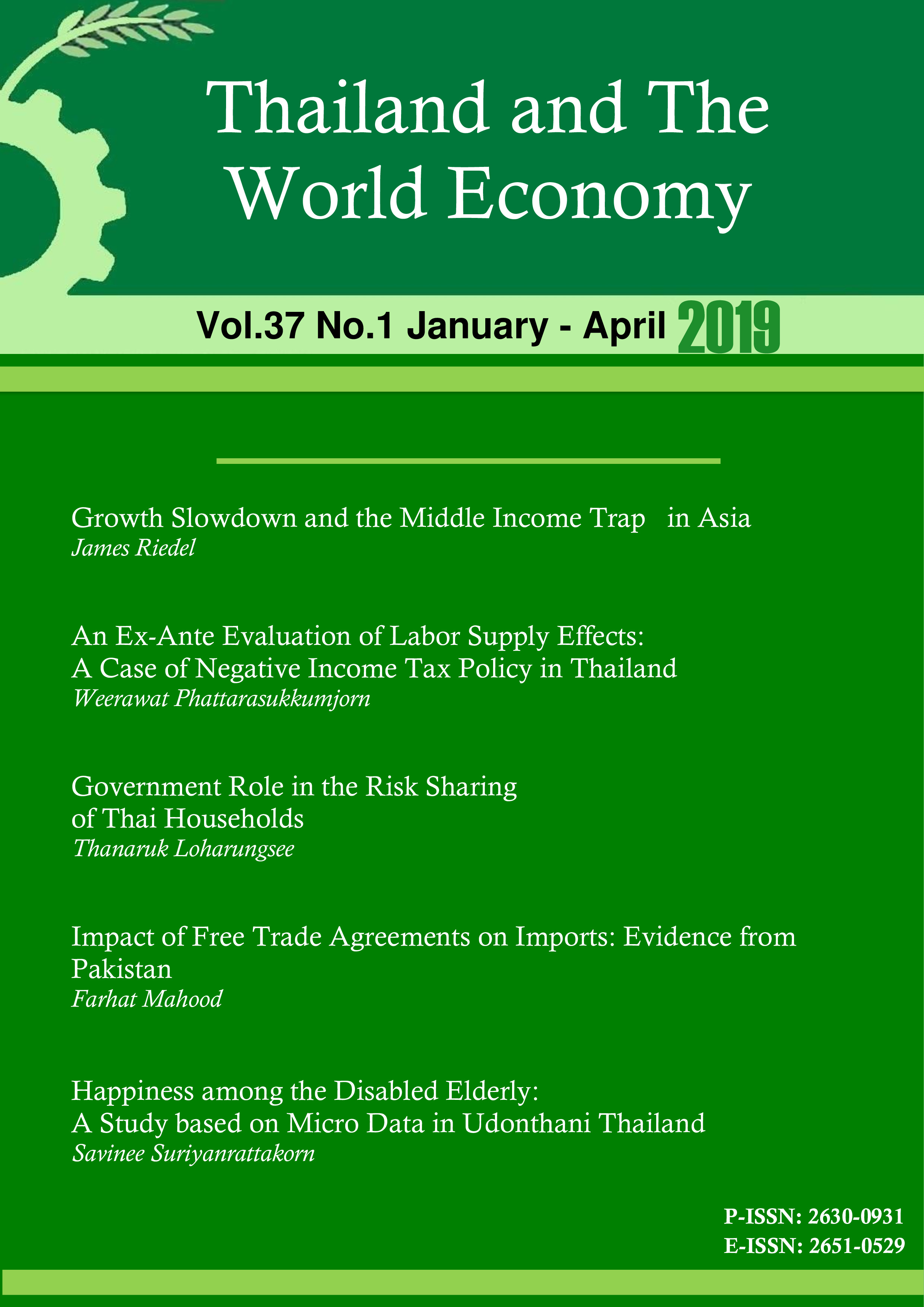Government Role in the Risk Sharing of Thai Households
Abstract
This paper estimates the impact of the government’s role on the risk sharing of Thai households, using a Household Socio-Economic Panel Survey data set (SES Panel) for the period between 2005 and 2010. This paper applies contrast estimator techniques, developed by Suri (2013), to estimate the extent of risk sharing. The results show that Thai households in rural areas share risks better than those in urban areas in most parts of the country. The contrast estimator also suggests that village funds help households in urban and rural areas to share risk, and government banks play an important role in risk sharing in rural areas. However, public transfers do not help risk sharing mechanisms in either urban or rural areas.
References
Alem, M. & Townsend, R. M. (2004). An evaluation of safety nets and financial institutions in crisis and growth. Working paper Dept of Economics 2004, University of Chicago.
Alem, M., & Townsend, R. (2014). An evaluation of financial institutions: Impact on consumption and investment using panel data and the theory of risk-bearing. Journal of Econometrics, 183(1), 91-103.
Boozer, M., & Cacciola, S. (2001) . Inside the black box of project star: Es-timation of peer effects using experimental data. Economic Growth Center Discussion Paper No.832, Yale University.
Chawanote, C. & Barrett, C. (2013). Farm and non-farm occupational and earnings dynamics in rural Thailand. Working Paper 2013, School of Applied Economics and Management, Conell University.
Chiappori, P., Samphantharak, K., Schulhofer-Wohl, S., & Townsend, R. (2014). Heterogeneity and risk sharing in village economies. Quantitative Economics, 5(1), 1-27.
Cochrane, J. (1991). A simple test of consumption insurance. Journal of Political Economy, 99(5), 957-976.
Cox, D., Eser, Z. & Jimenez, E. (1998). Motives for private transfers over the life-cycle: An analytical framework and evidence from Peru. Journal of Development Economics, 55(1), 57-80.
Deaton, A. (1990). On risk, insurance, and intra-village consumption smoothing, man-uscript. Princeton: Princeton University Press.
Deaton, A. (1997). The analysis of household surveys: A microeconometric approach to development policy. Baltimore, MD: Published for the World Bank by Johns Hopkins University Press.
De La Huerta, A. (2010). Microfinance in rural and urban Thailand: Policies, social ties and successful performance. University of Chicago.
Dercon, S., & Krishnan, P. (2003). Risk sharing and public transfers. The Economic Journal, 113(486), 86–94.
Diamond, P. (1967). The role of a stock market in a general equilibrium model with technological uncertainty. The American Economic Review, 57(4), 759-776.
Greenwood, J., & Jovanovic, B. (1990). Financial development, growth, and the distribution of income. The Journal of Political Economy, 98(5), 1076-1107.
Kananurak, P. & Sirisankanan, A. (2016). Do public transfers crowd-out private transfers? Evidence from the Thai socio-economic panel survey. Applied Economics Journal, 23(2), 29-47.
Kilenthong, W. T. (2015). Financial Access and Risk Bearing Ability of Thai Households. Unplubished manuscript.
Kinnan, C., & Townsend, R. (2012). Kinship and financial networks, formal financial access, and risk reduction. The American Economic Review, 102(3), 289-293.
Kinnan, C. (2014). Distinguishing barriers to insurance in Thai villages. Discussion Papers Series 0831, Department of Economics, Tufts University .
Lim, Y. & Townsend, R. M. (1998). General equilibrium models of financial systems: Theory and measurement in village economies. Review of Economic Dynamics, 1(1), 59-118.
Mace, B. (1991). Full insurance in the presence of aggregate uncertainty. Journal of Political Economy, 99(5), 928-956.
Morduch, J. (1995). Income smoothing and consumption smoothing. The Journal of Economic Perspectives, 9(3), 103-114.
Anan, P. (1997). A study of risk sharing and institutions in village Thailand (Doctoral dissertation, Thammasat University, 1997). Faculty of Economics, Thammasat University.
Paweenawat, A., & Townsend, R. (2012). Village economic accounts: Real and financial intertwined. The American Economic Review, 102(3), 441-446.
Ravallion, M., & Chaudhuri, S. (1997). Risk and insurance in village India: Comment. Econometrica, 65(1), 171-184.
Samphantharak, K., & Townsend, R. (2018). Risk and return in village economies. American Economic Journal. Microeconomics, 10(1), 1-40.
Scheinkman, J. (1984). General equilibrium models of economic fluctuations: A survey of theory. manuscript, University of Chicago.
Shawong, J. (2014). Risk sharing in rural and urban areas in Thailand. Southeast Asian Journal of Economics, 2(2), 49-75.
Sirisankanan, A. (2014). Do agricultural households share risks in Thailand? evidence from Thai socio-economic panel survey data. Asia-Pacific Development Journal, 20(2), 89-108.
Suri, T. (2013). Estimating the extent of local risk sharing between households. Unpblished manuscript.
Townsend, R. (1994). Risk and insurance in village India. Econometrica, 62(3), 539-591.
Townsend, R. (1995). Consumption insurance: An evaluation of risk-bearing systems in low-income economies. The Journal of Economic Perspectives, 9(3), 83-102.
Townsend, R., & Ueda, K. (2006). Financial deepening, inequality, and growth: A model-based quantitative evaluation. The Review of Economic Studies, 73(1), 251-280.
Townsend, R., & Jacob, Y. (2001). The credit risk-contingency system of an Asian development bank. Economic Perspectives, 25(3), 31-48.
Udry, C. (1990). Credit markets in northern Nigeria: Credit as insurance in a rural economy. The World Bank Economic Review, 4(3), 251-269.
Udry, C. (1994). Risk and insurance in a rural credit market: An empirical investigation in northern Nigeria. The Review of Economic Studies, 61(3), 495-526.
Vanitcharearnthum, V. & Jitsuchon, S. (2003). Recent development in poverty, risk-sharing, social safety nets and chronic poverty in Thailand. Paper submited to the World Bank under the WB/TDRI Poverty Reduction Partnership Phase 2.
Wilson, R. (1968). The theory of syndicates. Econometrica, 36(1), 119-132.







